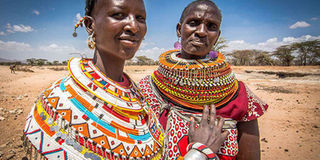Women embrace elephant task of protecting wildlife

Two members of The Mama Tembos. The Mama Tembos is made up of nine women from Samburu and Turkana, chosen by their communities to patrol wildlife and livestock corridors in the wider Samburu-Laikipia ecosystem. PHOTO | JANE WYNYARD
What you need to know:
- Since the Mamas began their patrols, there have been less reports of human-wildlife conflict and pressure on communities.
- Although the Mamas come from conflicting tribes and barely knew each other before the project began, they are now firm friends.
As Kenya's infrastructure continues to rapidly expand, one group of women in northern Kenya is breaking down barriers to ensure wildlife and livestock have the freedom to move through the landscape.
The Mama Tembos, nine women from Samburu and Turkana, have been chosen by their communities to patrol wildlife and livestock corridors in the wider Samburu-Laikipia ecosystem.
Working with the Kalama community conservancy and Save The Elephants, the Mamas record animal movements and give early warnings of attempts to create settlements along pathways used by elephants and other wildlife in the region.
In just five months, they are set to be a key weapon in the battle to create a harmonious future for humans and wildlife.
CONFLICTS
Armed with GPS tracking devices, data folders, these corridor guardians collect valuable data on wildlife movements, alert community authorities to the construction of illegal bomas and settlements that could potentially block wildlife and livestock movements, and talk to communities about the value of elephants and keeping passageways open.
Their mission is to help secure a future for wildlife, in particular elephants who use these pathways as critical lifelines to find food, water and mates, and protect local communities who live along the corridors.
Since the Mamas began their patrols, there have been less reports of human-wildlife conflict and pressure on communities and crops has greatly reduced.
David Daballen, Save The Elephants’ Head of Field Operations, says:
“We have seen through our research that elephants use well-established routes over and over again.
"When communities build settlements in the path of elephants, it can lead to disastrous consequences. Protecting wildlife corridors in northern Kenya however has huge impact, reducing negative interactions between local communities and elephants.”
COMMUNITY CONSERVANCY
The community-led corridor project in Kalama conservancy — situated in Archer’s Post Gir-Gir group ranch — is a shining example of how a successful community conservancy project can flourish in Kenya.
The respective communities appointed the individual Mamas who were chosen for their standing in their community, while the project benefits local tourism which, in turn, provides jobs for Samburu and Turkana people.
The Mamas, who are trained in basic elephant behaviour, identification of individual elephants and how to use a GPS system, are also well compensated.
They are able to educate their children and share their salaries with extended family members.
They have also gained the respect of their respective communities and local government, with people now starting to report wildlife sightings directly to the women.
PATROLS
The Mamas are named after the famous Mama Simbas, who work with Ewaso Lions to protect the region’s lions.
David Lekoomet, chairman of both the Kalama Conservancy Board and NRT’s Council of Elders, says:
“The Samburu community live side by side in harmony with wildlife and elephants, and these iconic creatures are incredibly important to us.
"It is a sign of great respect that our communities chose women to carry out the role of protecting wildlife and livestock passages and we fully acknowledge and support their efforts. I hope other communities will emulate what we are trying to do.”
Although the Mamas come from conflicting tribes and barely knew each other before the project began, they are now firm friends.
They patrol the corridors twice a day — early morning and late afternoon — sometimes walking up to 10 kilometres a day.
INFRASTRUCTURE
Most of the women have had tough lives, struggling to raise children on their own after their partners and husbands abandoned them or were killed in tribal conflicts.
Says Ann of the Mama Tembos: “We were very surprised to hear there were job opportunities that only required women in this male dominated society. We feel empowered by the opportunity and are now teachers and ambassadors of our communities.”
With Kalama Conservancy fully supporting the corridors project, the hope is the initiative will secure a basis in law.
Kalama Conservancy and Save The Elephants also want other communities to be inspired by the steps taken in northern Kenya, and to protect their own wildlife and livestock corridors.
Mr David Daballen of Save The Elephants says:
“It would be a shame if mankind was responsible for the demise of elephants because we blocked their natural movements with development and infrastructure.
"Protecting corridors provides a solution that meets the needs of the wildlife but also enables Kenya to design and develop its infrastructure with wildlife conservation in mind."
Wynyard is a freelance photographer and writer with a passion for elephants and the environment.




